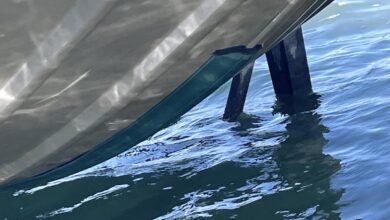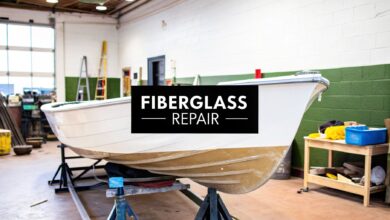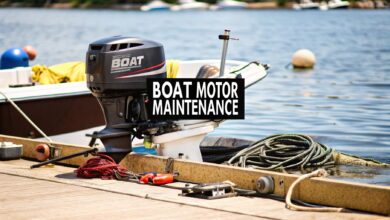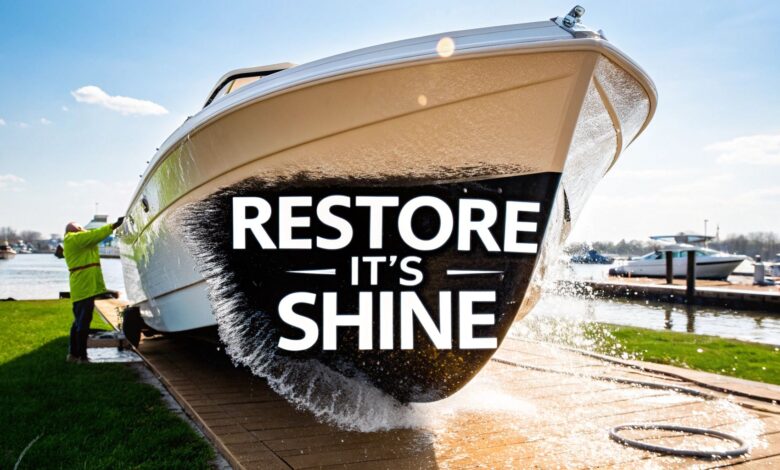
Before you even think about putting a hose to the hull, let's talk about prep. Getting all your gear in one place isn't just about saving time; it's about getting a professional result without causing unintended damage. Think of it like a surgeon's tray—everything has its purpose and is ready to go.
Gathering Your Essential Cleaning Gear

A well-stocked cleaning kit is your best friend on wash day. If you have to stop mid-scrub to hunt down a brush, you’re giving soap a chance to dry on your hull. This leads to stubborn water spots and streaks that are a pain to remove later.
The cornerstone of your kit is a quality boat soap, not dish soap. Household detergents strip the protective wax right off your gelcoat. Always use a dedicated, pH-neutral and biodegradable boat soap to cut through grime without dulling your finish.
Brushes and Mitts for Every Surface
You wouldn't use a hammer to turn a screw, so don't use one brush for your whole boat. A long-handled, soft-bristle brush is a back-saver for reaching down the sides of the hull. For tough non-skid surfaces, you'll need a medium-bristle brush to get embedded dirt out.
A soft wash mitt is perfect for easy-to-reach and more delicate areas. A big stack of clean microfiber towels is also non-negotiable. They are essential for a streak-free finish when drying.
A common rookie mistake is attacking the entire boat with a single, stiff-bristled brush. You might as well be scrubbing it with fine-grit sandpaper. That’s how you get the fine scratches and swirl marks that kill a gelcoat's shine.
Your Boat Wash Checklist
Here’s the gear to have on the dock before you start:
- Two Buckets: One bucket is for soapy water, and the second is for clean rinse water. Dipping your dirty mitt in the rinse bucket first keeps grime out of your soap. This is the secret to not just rubbing dirt all over your boat.
- Marine-Grade Boat Soap: Check the label to ensure it’s biodegradable and safe for waxed surfaces.
- A Set of Brushes: At a minimum, have a long-handled soft brush and a medium-stiffness brush for non-skid decks.
- Wash Mitt: A quality chenille or microfiber mitt is ideal for hands-on cleaning.
- Microfiber Towels: You can never have too many, especially large, absorbent ones for drying.
The Pre-Wash and Initial Rinse
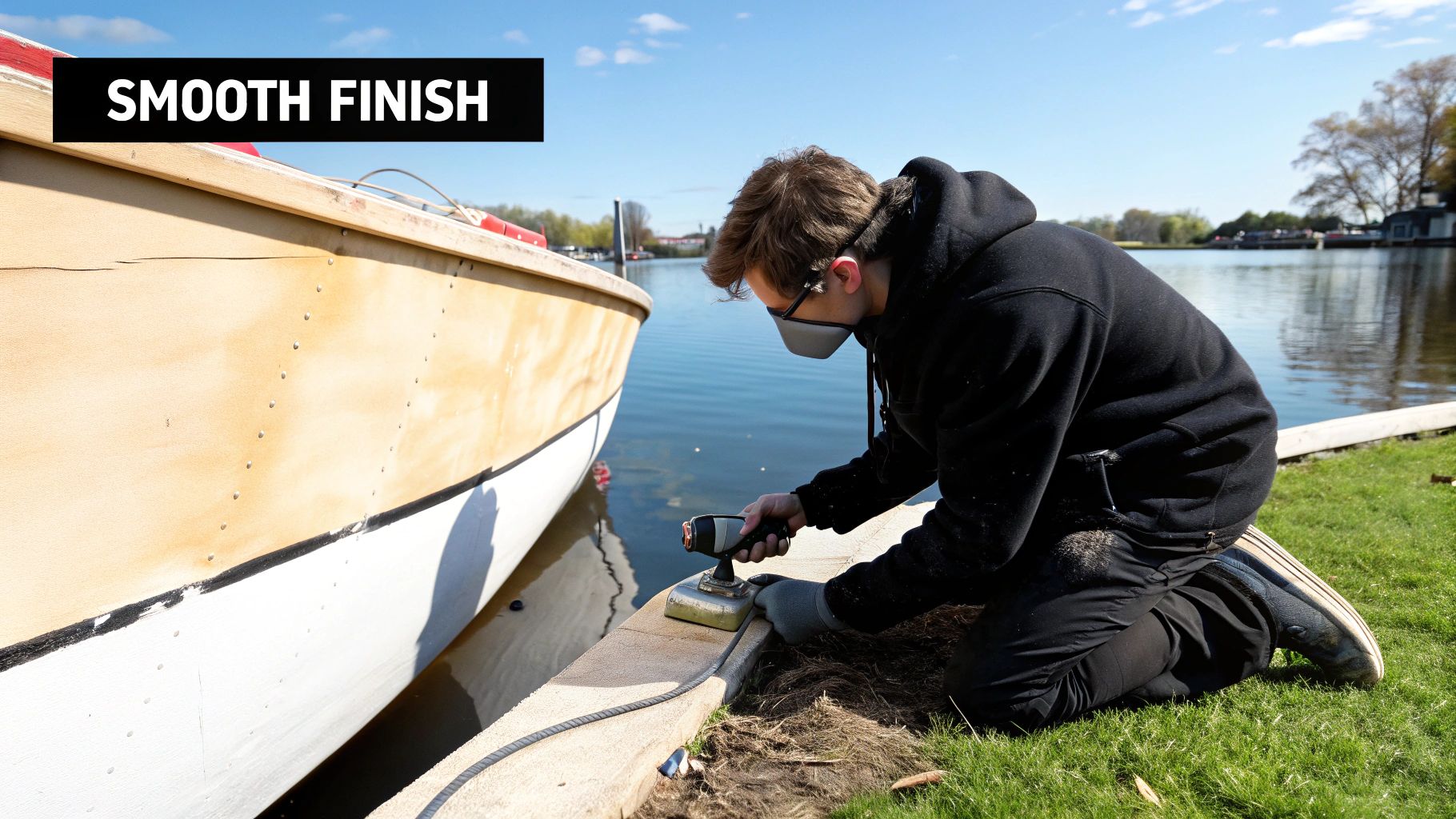
Before grabbing a brush, give your boat a solid rinse with fresh water. It’s a simple step that many people skip. Trust me, it makes a world of difference.
Always start from the top and work your way down. Gravity is your best friend here. The goal is to knock off all loose debris like salt, dust, and bird droppings.
If you don't rinse first, you’re essentially turning your wash mitt into sandpaper. You’ll grind abrasive particles into your gelcoat, creating scratches and swirl marks. A quick rinse clears the deck for the real cleaning.
Can You Use a Pressure Washer?
Absolutely, and a pressure washer can be a huge time-saver for the initial rinse. But you have to be smart about it. Using too much pressure can cause serious damage.
A pressure washer is a tool for rinsing, not for sandblasting. High pressure can chip gelcoat, peel decals, and destroy sealant. That's a shortcut to some very expensive repairs.
If you use a pressure washer, follow a few simple rules. Use a wide-angle spray tip, like a 40-degree (white) nozzle. Keep the nozzle at least two to three feet away from the surface.
Never aim the spray directly at decals, pinstriping, or caulked seams. Focus on stubborn areas like scuppers or non-skid deck patterns. Loosening that grime now will make the main wash much easier.
Washing and Scrubbing for a Deep Clean
Now that the boat has been rinsed, it’s time to get down to business. The best way to wash fiberglass without scratching it is the classic two-bucket method. It’s a simple trick that makes a huge difference.
Grab two buckets: one for your soap solution and one for clean rinse water. Dip your mitt in the soap, scrub a small section, then rinse the dirty mitt in the clean water bucket. This prevents grit from contaminating your soap and being dragged across the hull.
Always start at the highest point and work your way down. This prevents soapy streaks from drying on surfaces you haven't cleaned yet. It saves you from cleaning the same spot twice.
Getting Into the Gritty Details
For stubborn, non-skid areas on the deck, a wash mitt won't cut it. You'll need a medium-bristle brush to dig into the grooves and lift out dirt. This methodical, top-down approach ensures a truly deep clean.
The boat cleaner market has expanded due to more people boating and a focus on eco-friendly products. The boat hull cleaner market is projected to hit $500 million in 2025. It is expected to grow at a 6% rate through 2033.
Picking the right cleaner is half the battle. Here’s a quick rundown of what to use and when.
Choosing the Right Marine Cleaner
| Cleaner Type | Best For | Key Feature |
|---|---|---|
| All-Purpose Soap | General washing of decks, hulls, and vinyl. | pH-balanced and biodegradable, safe for most surfaces. |
| Hull Cleaner | Removing tough waterline stains, algae, and rust. | Often acid-based for heavy-duty cleaning power. |
| Non-Skid Deck Cleaner | Textured fiberglass surfaces where dirt gets trapped. | Contains chelating agents to lift grime without harsh scrubbing. |
| Black Streak Remover | Eliminating ugly black streaks from runoff. | Targeted formula that dissolves stains without harming gelcoat. |
Having a few specialized cleaners on hand will make your life easier. It will also give you far better results than relying on a single all-purpose soap. Once clean, the next stage is all about protection and shine.
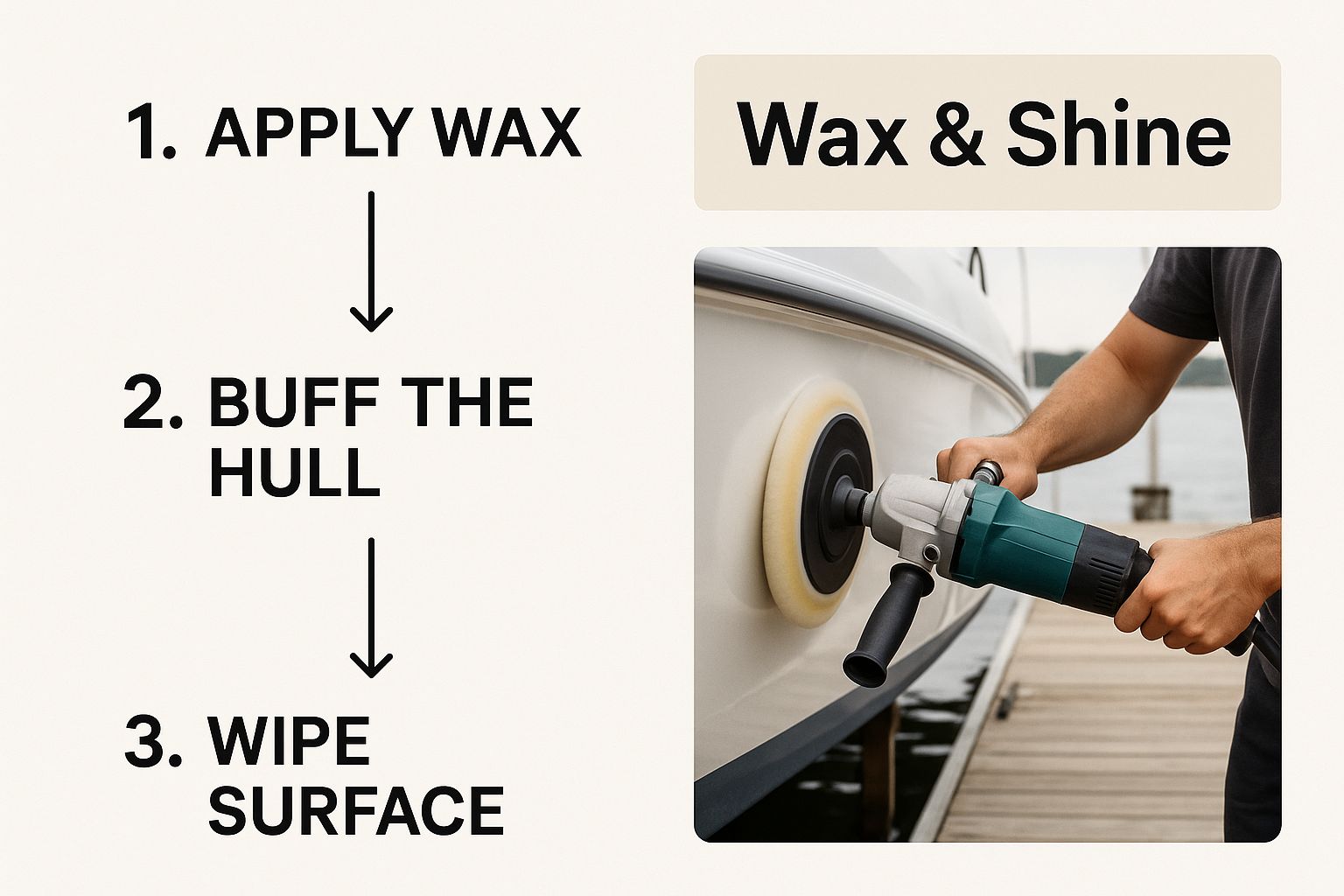
A proper wax job isn't just for looks; it creates a protective barrier against UV rays and salt. For a deeper dive into techniques, you can explore our comprehensive guide on cleaning a boat.
Tackling Tough Stains and Oxidation
A good wash often reveals more stubborn blemishes on your boat's fiberglass. You know the ones: yellow "tannin" stains at the waterline and ugly black streaks from hardware. Your everyday boat soap won't cut it for these.
Each type of stain requires a specific battle plan. For waterline stains, use an acid-based hull cleaner. For black streaks, a dedicated remover will break them down without harming the gelcoat.
Restoring Your Gelcoat From Oxidation
If your boat’s hull looks faded, chalky, and dull, you’re seeing oxidation. This is the result of sun exposure breaking down the gelcoat. No amount of scrubbing will bring back that shine.
To fix this, you’ll need a rubbing compound or a polish. The goal is to gently cut away the top layer of dead gelcoat. This reveals the fresh, vibrant finish underneath.
Always start with the least abrasive product necessary. For more serious issues, knowing how to perform an effective boat gelcoat repair is a crucial skill. If you find deep cracks, our guide on fiberglass boat repair can help you decide on next steps.
Restoring an oxidized gelcoat is a lot like exfoliating your skin. You're gently buffing away the dull, damaged top layer to expose the healthy, glowing surface just below.
The market for these specialized cleaners is booming. In 2025, the global boat cleaner market was valued at roughly $1.5 billion. You can discover more insights about the boat cleaner market from Archive Market Research.
Applying Wax for Lasting Protection
You've put in the elbow grease, and your boat is looking fantastic. Now it's time to lock in that shine. Applying a quality marine wax is what separates a good cleaning job from a great one.
Think of it like sunscreen for your boat. This final layer is your best defense against UV rays, salt spray, and grime. A properly waxed hull also makes your next cleanup a breeze.
Choosing Your Wax: Carnauba vs. Polymer
You'll mainly see two types of wax: traditional carnauba and modern polymer sealants.
- Carnauba: This is the old-school favorite for a deep, wet, show-stopping gloss.
- Polymer Sealants: These are the workhorses, creating a durable shell that can last an entire season.
I'm a fan of hybrid waxes that blend both. You get the best of both worlds—a brilliant shine and long-lasting protection.
For larger boats, your arms will thank you for using a power tool. A quality orbital polisher, like the Milwaukee 2684 20 M18 Fuel 15mm Random Orbit Polisher Bare Tool, lays down a thin, even coat.
This is a massive part of boat care. The global boat polish market hit $145 million in 2024, with 65% used on fiberglass boats. You can see the full breakdown in the boat polish market report from DataHorizzon Research.
Applying wax is more than just an aesthetic choice—it's preventative maintenance. A properly waxed hull is the best defense against the gradual, chalky degradation caused by the sun.
Getting that perfect, haze-free finish takes a bit of technique. For a full walkthrough, check out our guide on how to wax a boat.
Common Fiberglass Cleaning Questions
Even with the best plan, you're bound to have questions. Getting the right answers can save you time and help you avoid costly mistakes. Let’s tackle some common concerns.
One of the first things people ask is how often they need to scrub the hull. The honest answer is: it depends.
How Often Should I Wash My Fiberglass Boat?
Where and how often you boat are the biggest factors. For saltwater boaters, a quick freshwater rinse after every outing is non-negotiable. Beyond that, a proper wash is needed every 2-4 weeks.
Freshwater boaters have more breathing room. A thorough cleaning every 4-6 weeks is usually enough. This keeps lake scum and algae from getting a foothold.
Another common question is about using household cleaners. It's tempting, but it's one of the worst things you can do.
Using household dish soap is one of the fastest ways to strip wax right off your gelcoat. This leaves the fiberglass completely exposed to the sun's damaging UV rays, which is what kickstarts the whole oxidation process.
Can I Use Household Cleaners on My Boat?
In short, just don't do it. Cleaners like dish soap cut through grease and oil, which is what your protective wax is. Once that wax is gone, your gelcoat is defenseless.
Harsh chemicals like bleach or ammonia can permanently damage gelcoat. They also cause vinyl to fade and crack. Stick to products made specifically for marine environments.
Finally, let's clear up the confusion between two very different jobs.
What Is the Difference Between Polishing and Waxing?
It’s simple when you break it down: polishing corrects, while waxing protects.
-
Polishing is about restoration. It uses a fine abrasive to buff away the chalky, oxidized top layer of gelcoat. You do this to fix a dull or lightly scratched surface.
-
Waxing is pure protection. It lays down a non-abrasive barrier to shield the gelcoat from UV rays, salt, and grime. Think of it as sunscreen for your boat.
The order is crucial. Always wash first, then polish if needed, and always finish with a coat of wax. This seals in the shine and protects all your hard work.
At Boating Articles, we provide the expert guidance you need to keep your vessel in pristine condition. For more in-depth tutorials and product recommendations, visit us at https://boating-articles.com.

